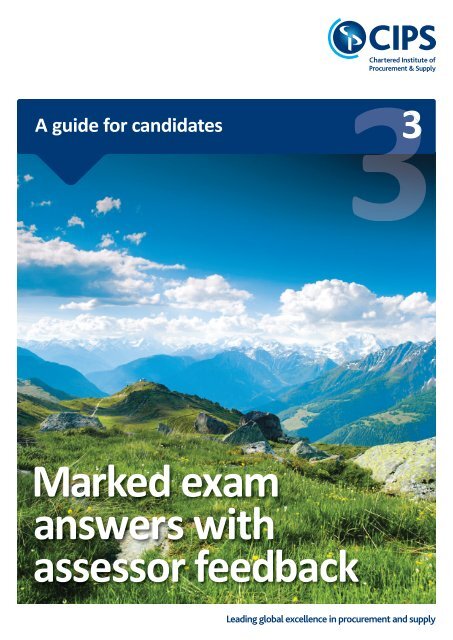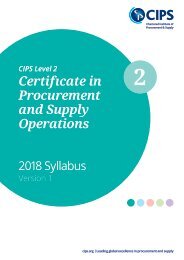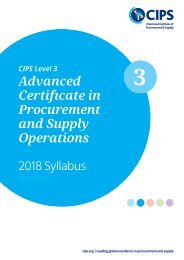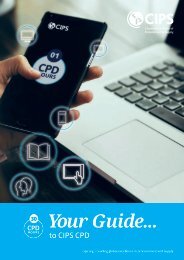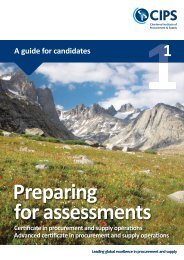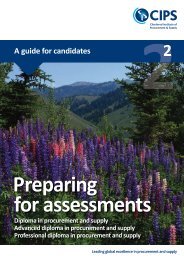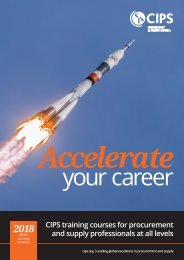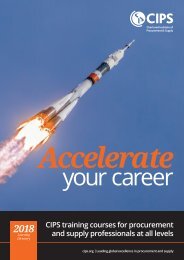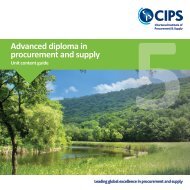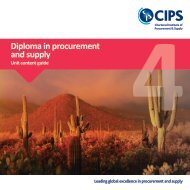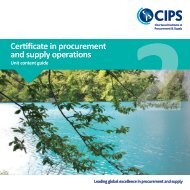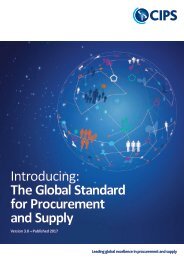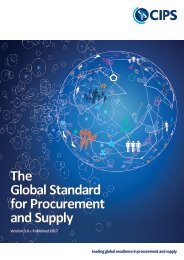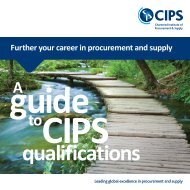Marked exam answers with assessor feedback
You also want an ePaper? Increase the reach of your titles
YUMPU automatically turns print PDFs into web optimized ePapers that Google loves.
A guide for candidates<br />
3<br />
<strong>Marked</strong> <strong>exam</strong><br />
<strong>answers</strong> <strong>with</strong><br />
<strong>assessor</strong> <strong>feedback</strong><br />
Leading global excellence in procurement and supply
How to approach<br />
unseen case studies<br />
<strong>with</strong> questions<br />
Suggestions, hints and tips for the assessment<br />
• Read the case study and the case questions through<br />
quickly to start <strong>with</strong> in order to get a general overview of<br />
what it is about, and to help you settle down to thinking.<br />
Then, read the case study through again more carefully,<br />
this time <strong>with</strong> a pen at the ready to make a few notes and<br />
annotate the case study throughout. It is beneficial to<br />
write any notes in your answer booklet (you can cross<br />
them out at the end). That way, if you run out of time, the<br />
<strong>assessor</strong> can read your notes which may give him or her<br />
an insight to your analysis<br />
• Next, identify the contextual information, such as the<br />
background data that sets the scene for the key issues. For<br />
<strong>exam</strong>ple, if there is financial information, or information<br />
on trends, size of the business or procurement spend,<br />
then it is useful to highlight these and consider their<br />
relevance to the case study.<br />
• Then identify the key issues that are presented in the<br />
case and try to prioritise these, including any that<br />
appear to be peripheral to the main case.<br />
Timing is everything<br />
• We recommend you spend 20 minutes on ‘Reading case<br />
study material and all questions’<br />
• As you read through the paper, identify what is being<br />
asked of you in each question or each part of a question.<br />
Remember, there will be one question for each of the<br />
learning outcomes in the ‘Unit Content Guide’:<br />
Determine which part of the subject unit content the<br />
question relates to<br />
Consider what elements of the case study are relevant<br />
to this topic, and the key issues the question is asking<br />
you to write about<br />
Check the number of marks allocated to each question<br />
or part of a question: this helps you to work out how<br />
much information the <strong>assessor</strong>s are expecting you to<br />
include in your answer to each part<br />
Take careful note if the question asks you to provide a<br />
specific number of <strong>exam</strong>ples or ideas – make sure you<br />
provide the number required.<br />
• Next, highlight the command words in each question or<br />
part of a question. (See page 16 for <strong>exam</strong>ples of command<br />
words and what they mean.)<br />
www.cips.org
Recommended time to spend on unseen case study assessments (three hours duration)<br />
Diploma<br />
Advanced &<br />
Professional Diploma<br />
Reading case study material and all questions 20 minutes 20 minutes<br />
Planning/making notes for <strong>answers</strong> (per question) 4 minutes 4 minutes<br />
Writing (per question) 25 minutes 33 minutes<br />
Checking/amending (per question) 2 minutes 2 minutes<br />
Checking that you have correctly followed the instructions, missed<br />
nothing out, labelled everything, last-minute amendments<br />
(per assessment)<br />
5 minutes 4 minutes<br />
20<br />
04 mins<br />
05 mins<br />
mins<br />
25 02<br />
33 mins<br />
mins<br />
mins<br />
03
Improving your approach to<br />
answering <strong>exam</strong> questions<br />
A case study is a brief overview of<br />
a business situation<br />
The purpose of the case study is to allow you to demonstrate your ability to analyse and comment<br />
on a procurement and supply situation under assessment conditions. To do this effectively you<br />
need to know, understand and have experience of the application of the relevant theory.<br />
This is a real <strong>exam</strong> question paper used in a previous<br />
<strong>exam</strong> series. In it you will find actual marker <strong>feedback</strong><br />
based on the <strong>answers</strong> of students. It is especially helpful<br />
in this instance as it links the question and the <strong>answers</strong><br />
to the case study and the reason why the final mark was<br />
awarded.<br />
This resource not only helps for the type of question but<br />
will also help you to improve your generic <strong>exam</strong><br />
technique.<br />
Remember good <strong>answers</strong> will be well reasoned and<br />
justified <strong>with</strong> appropriate theories, models or <strong>exam</strong>ples.<br />
The following <strong>exam</strong> question was used for students<br />
sitting the D3 – Sourcing in procurement and supply<br />
<strong>exam</strong>.<br />
www.cips.org
Unseen Case study <strong>exam</strong>ple – Sourcing in procurement and supply<br />
The Global Fund to Fight AIDS, Tuberculosis and Malaria<br />
(GFATM) is an international organisation that aims to<br />
attract and distribute resources to prevent and treat HIV<br />
and AIDS, tuberculosis and malaria. The organisation has<br />
its headquarters in Geneva, Switzerland. It is financed by<br />
government grants and public donations.<br />
GFATM intends to develop its sourcing and procurement<br />
activities. It has recently carried out a review to explore<br />
how efficiency could be improved, to develop increased<br />
commercial expertise in its field staff, and therefore<br />
achieve greater transparency on costs and payments.<br />
Malaria, which is carried by mosquitoes, kills many<br />
thousands of people every year, many of whom are<br />
children. One of its first sourcing activities under this new<br />
approach was to carry out the world’s largest tender for<br />
the supply of mosquito nets, designed to produce<br />
estimated savings of $140 million for GFATM over two<br />
years. The project would provide 190 million bed nets and<br />
protect 400 million people at risk of malaria in 30 African<br />
and Asian countries. The lives of an estimated 1.3 million<br />
children could be saved.<br />
A new sourcing process was established to organise the<br />
structured purchase of mosquito nets, shifting the power<br />
from seller to buyer. The process focused on reducing the<br />
market dominance of individual manufacturers and<br />
mosquito net suppliers. There would be a strong focus by<br />
GFATM on local production and suppliers using this new<br />
approach. Long-term contracts resulting from the new<br />
sourcing process would improve visibility, production,<br />
capacity planning and pricing.<br />
Another aim of the sourcing exercise was to generate<br />
overall value by ordering more nets of a standard size and<br />
simplifying manufacturing processes to cut costs.<br />
Previously the number of mosquito net specifications was<br />
very wide. Through standardisation and reduced prices, a<br />
third more nets could be bought <strong>with</strong>in the same budget.<br />
By using large-scale purchasing power, the new process<br />
would provide better value for money, providing savings<br />
and the reduction of supply chain bottlenecks and<br />
shortages.<br />
The new sourcing process was also meant to achieve a<br />
balanced sustainable supply chain. Contracts would be<br />
spread among a number of suppliers and this would<br />
support innovation, optimise capacity and reduce risk in<br />
GFATM’s supply chain.<br />
In addition, the sourcing process would support domestic<br />
production in countries <strong>with</strong> high demand for mosquito<br />
nets, which would lower transportation costs and utilise<br />
advice from local experts.<br />
However, the move towards using smaller local suppliers<br />
would need to be managed carefully in order to ensure<br />
the suppliers’ financial stability. The mosquito net<br />
sourcing exercise was part of a more proactive approach<br />
to procurement being adopted by GFATM. The<br />
organisation aims to follow it up <strong>with</strong> a similar sourcing<br />
exercise for medical supplies.<br />
The GFATM sourcing team has introduced a strategic<br />
review of its approach to sourcing and is trying to gain a<br />
better understanding of market dynamics.<br />
The strategic review process aims to promote capability<br />
development throughout the supply chain, including<br />
better coordination and cooperation. Expected outcomes<br />
of the strategic review process include the better<br />
understanding of stakeholder needs, comprehensive<br />
supply market intelligence, a common sourcing process,<br />
reduced costs, and improved innovation.<br />
This is a collaborative approach which should help GFATM<br />
to achieve common objectives and eliminate duplication<br />
of effort.<br />
Sources:<br />
• www.supplymanagement.com - 14 October 2014<br />
• www.globalfund.org - January 2015<br />
• www.guardian.com - 15 November 2013<br />
05
Question 1: Discuss FOUR criteria that GFATM might apply when awarding the contracts to suppliers<br />
(20 marks)<br />
Sample answer:<br />
Award of contracts is made to suppliers when the ‘best’ option,<br />
value or price had been determined. Each supplier would be<br />
assessed on their suitability, acceptability and capability, that<br />
they can bring to the requirement at that time and potentially<br />
moving forward <strong>with</strong> later procurement or requirements.<br />
Award criteria needs to cover both technical and commercial<br />
criteria. Technical is that the supplier has the knowledge, skills,<br />
expertise to deliver the contract. Commercial criteria is that the<br />
supplier has the financial status, innovation and ‘best’ solution to<br />
deliver the contract.<br />
Assessor comments:<br />
A good, but lengthy, introduction. It<br />
contextualises the answer, but it doesn't<br />
contribute anything to the answer and no marks<br />
can be awarded for it at this stage. The body of<br />
the answer duplicates some of this content.<br />
No specific marks are given for the introduction<br />
but it does demonstrate some understanding of<br />
the subject matter.<br />
The case study refers to GFATM wishing to reduce supply chain<br />
bottlenecks and shortages. To achieve this they could use the<br />
Kraljic matrix to help them visualise which products are in which<br />
quarter and what they can do to improve where possible.<br />
The Kraljic matrix rates how complex the supply chain is <strong>with</strong><br />
how important the item is to the organisation so that a plan can<br />
be devised regarding the amount of time, effort and resource is<br />
dedicated to the purchase type.<br />
Complexity of supply chain<br />
Low<br />
High<br />
Importance of item<br />
High<br />
Low<br />
Non-critical<br />
items<br />
Strategic items<br />
Partnering<br />
Bottleneck<br />
items<br />
www.cips.org
1 Innovation<br />
The supplier is the expert in their field and so by using early<br />
supplier involvement and using the expertise to look at the<br />
material grade, quality may end up <strong>with</strong> a product that<br />
matches or exceeds the original specification for the same or a<br />
lower cost.<br />
The product may be of a better quality and be more durable<br />
and therefore more cost effective. This may lead to a better<br />
reputation in the field/brand for the supplier whilst delivering<br />
the protection required- a win/win for buying organisation<br />
and supplier.<br />
2 Capacity<br />
GFATM would want to know that the supplying organisation<br />
had the capacity to produce the quantity of mosquito nets<br />
require. As they are standardising the net there will be less<br />
variation and so potentially they will have one supplier who<br />
will have the required machinery to provide the specified net<br />
in the quantity that is required.<br />
3 Quality<br />
GFATM would want to ensure that the supplier being awarded<br />
the contract have good, robust quality ethics. Quality control<br />
is checking the item (usually a random quantity i.e. 5% as<br />
organisational policy) after it is made and rejecting the item if<br />
found to be faulty this can lead to waste. Quality assurance is<br />
however looking at the processes involved <strong>with</strong>in the<br />
manufacture of the item ensuring that the item is correct and<br />
fit for purpose the first time. This would include monitoring<br />
the materials used, the process and removing any waste<br />
procedures and a quality culture from the management team<br />
down to the shop floor employees.<br />
4 Price/best value for money<br />
Ensuring that the best quality product is provided for the best<br />
possible price. MEAT- Most economically advantageous<br />
tender- as GFATM are a third sector buying organisation they<br />
may not be looking at price only. As the funding comes via<br />
government grants and public donations their funding is<br />
under huge scrutiny as they are spending public money.<br />
3/5 marks<br />
Innovation – this is one of the relevant criteria<br />
for contract award. This part of the answer could<br />
have been improved by reference to the case<br />
study information.<br />
For <strong>exam</strong>ple, the case study information states<br />
that GFATM has recently carried out a review to<br />
explore how efficiency could be improved.<br />
Innovation on the part of the supplier might<br />
help to achieve this.<br />
3/5 marks<br />
Capacity – this is also a relevant point. But more<br />
discussion of what capacity means, in addition to<br />
machinery, would have resulted in a higher mark,<br />
e.g. manpower and financial resources.<br />
4/5 marks<br />
Quality - this is a good answer, of a distinction<br />
pass standard. A good knowledge of quality<br />
control and quality assurance is demonstrated.<br />
TQM could have been mentioned.<br />
4/5 marks<br />
Value for money - a good understanding of<br />
price, best value for money and MEAT is<br />
demonstrated. Also, it is applied to GFATM and<br />
the fact that it is a third sector organisation.<br />
Total mark = 14/20, a strong credit pass answer<br />
07
Question 2: A new and structured sourcing process was established by GFATM as part of its new<br />
proactive approach to procurement. This would involve the development of sourcing plans for goods<br />
and services from external suppliers.<br />
Describe FIVE elements that GFATM should include in sourcing plans<br />
(20 marks)<br />
Sample answer:<br />
Carter’s 10 Cs<br />
1 Ethics/Corporate social responsibility (CSR)<br />
As GFATM are sourcing internationally and as stated in<br />
the case study looking to place some contracts <strong>with</strong><br />
suppliers using the mosquito nets, the countries may<br />
not be developed and so to ensure GFATMs<br />
reputation they would have to ensure that labour and<br />
pay for these countries were fair and equal, child<br />
labour is not used and that the relevant laws are<br />
adhered to.<br />
2 Staffing/expertise<br />
The case study states that GFATM are looking to<br />
develop the commercial expertise of its field staff. This<br />
would give the staff a better understanding and<br />
knowledge of the sourcing procedures and GFATM<br />
sourcing plan as an organisation. As GFATM are a third<br />
sector organisation the transparency they would<br />
achieve and expert knowledge would be of great<br />
benefit.<br />
3 Stakeholders needs/ compliance<br />
Stakeholders are individuals or organisations that can<br />
influence or put pressure on the organisation in either<br />
a positive or negative manner. Stakeholders can be<br />
either internal or external to the organisation. In the<br />
case of GFATM the stakeholders would be their<br />
employees, directors, supplier, taxpayers, public,<br />
service users. It is important to have stakeholder buyin<br />
to ensure that the best value for money is achieved.<br />
4 Market intelligence/ continuity<br />
It is important that GFATM looks at the market to<br />
review the options <strong>with</strong>in it. This involves reviewing<br />
current suppliers as well as seeking new suppliers and<br />
the innovation and experience they can bring to add<br />
value and expertise to the individual requirement or<br />
project.<br />
5 Locality/transportation<br />
By using local suppliers and reducing the<br />
transportation required to get the finished product to<br />
its place of need bring value in that sustainability,<br />
‘green’ practice is used. It uses the skills of local<br />
workers bringing economic viability to the areas and<br />
potentially improving their living and working<br />
conditions.<br />
Assessor comments:<br />
This was not a good answer and much of it did not<br />
address the question. The candidate has used sections of<br />
the Carter model of supplier evaluation as the basis of<br />
their answer and this is only indirectly relevant.<br />
A good answer would have described five of the<br />
following elements or others that GFATM could have<br />
included in a sourcing plan:<br />
• Whether the supply base should be wide or narrow<br />
• Whether sourcing should be by negotiation or tender<br />
• Should there be partnership relationships or arm’s<br />
length agreements or any of the options between<br />
these extremes<br />
• Set up a supplier appraisal process<br />
• Develop KPI's to monitor supplier performance<br />
• Consider supplier development activities to be<br />
included in the sourcing plan<br />
These should have been applied to the case study<br />
information for higher marks.<br />
Some marks was awarded for mention of the Carter 10<br />
C's model, the section on Ethics/CSR and the section on<br />
stakeholders, because they are involved in the sourcing<br />
process.<br />
Marks were also awarded for the section on market<br />
intelligence, as this could be considered to be part of a<br />
sourcing plan.<br />
Marks were awarded for the section on locality, because<br />
this was related to the case study information.<br />
Total mark awarded = 9/20, a fail grade answer overall,<br />
mainly because it lacked breadth of detail and depth of<br />
detail. The individual points made were generally valid.<br />
www.cips.org
Question 3a: The case study information states that the move towards using smaller local suppliers<br />
would need to be managed carefully in order to ensure the suppliers’ financial stability.<br />
Describe THREE sources of financial information about suppliers which could be used to assess their<br />
financial stability. (9 marks)<br />
Sample answer:<br />
1 Presentation<br />
The supplier could be asked to make a presentation to the<br />
buying organisation’s finance and procurement managers. They<br />
would outline where they are financially, how they have<br />
improved, any information they could give that shows them to<br />
be a sound, financially healthy organisation. No current or<br />
potential supplier should refuse this opportunity.<br />
2 Credit rating companies<br />
Usually used by using an online website i.e. Experion or Dun +<br />
Bradstreet. For a small fee the credit rating company would<br />
supply information regarding the supplier’s financial health and<br />
status.<br />
3 Using financial statements<br />
For <strong>exam</strong>ple balance sheets, cash flow statements and profit<br />
and loss accounts. The information can be used to calculate<br />
indicators and ratios that can help in the assessment of a<br />
suppliers financial health.<br />
Assessor comments:<br />
3/3 marks<br />
A very good answer.<br />
2/3 marks<br />
Lacks some detail, but the main point is covered.<br />
2/3 marks<br />
Lacks some detail, but the main points are<br />
covered.<br />
Total mark for part (a) = 7/9, a good answer<br />
overall.<br />
Development of the credit rating and financial<br />
statements responses would have been beneficial<br />
as they are both rather brief.<br />
09
Question 3b: Describe TWO liquidity ratios that GFATM might use to assess a supplier’s financial<br />
stability. (6 marks)<br />
Sample answer:<br />
1 Quick ratio or acid test ratio<br />
Assets – stock =<br />
Liabilities<br />
Assessor comments:<br />
2/3 marks<br />
The formula given is incorrect. It should be current<br />
assets - stock divided by current liabilities. But 2<br />
marks awarded for the narrative, which is correct.<br />
This is the more accurate of the liquidity ratios as it removes<br />
unsold stock from the financial indicator. The ratio ideally<br />
should be one or above indicating that the company has<br />
sufficient ‘cash’ to be able to pay its liabilities in the short term.<br />
Stock is removed as it may take time to sell/invoices to be paid<br />
and so the cash is not freely available.<br />
2 Working capital ratio<br />
Assets =<br />
Liabilities<br />
Ideally this indicator total should be 2 or above again indicating<br />
that the organisation has sufficient ‘cash’ to cover their short<br />
and long term liabilities. It is important that this is only a<br />
snapshot taken by using the company’s balance sheet. This<br />
information would only be true on the date of the balance<br />
sheet and so may be outdated.<br />
0/3 marks<br />
The working capital ratio is not a liquidity ratio.<br />
The formula given is not used as a financial<br />
liquidity ratio. Current assets and current<br />
liabilities are the items and their elements that are<br />
compared to analyse liquidity.<br />
Total mark for part (b) = 2/6, a fail grade answer.<br />
Question 3c: Explain the significance of liquidity ratios to GFATM in assessing the financial stability of a<br />
supplier. (5 marks)<br />
Sample answer:<br />
1 The liquidity ratios give an idea as to how much cash the<br />
supplier has to cover its own liabilities or debts. This would also<br />
indicate whether a supplier is likely to have good financial<br />
health and resource to take on additional business of producing<br />
more or any mosquito nets. The supplier may need to employ<br />
additional staff, purchase materials to start the contract <strong>with</strong><br />
payment from GFATM not coming for maybe a month or two<br />
depending on the terms agreed in the contract.<br />
Assessor comments:<br />
3/5 marks<br />
This answer lacks some detail. Debtors, and the<br />
other different <strong>exam</strong>ples of current assets, could<br />
be included in the explanation. A mark of a credit<br />
standard is justified.<br />
Total mark for part (c) = 3/5<br />
Total mark for Q3 is = 12/20, a credit pass grade,<br />
mainly because of the good answer to part (a).<br />
www.cips.org
Question 4a: One of GFATM’s first sourcing activities was to carry out the world’s first tender for the<br />
supply of mosquito nets. The organisation aims to follow it up <strong>with</strong> another sourcing exercise for medical<br />
supplies.<br />
Outline FOUR electronic systems that GFATM could use to source its requirement from external<br />
suppliers. (8 marks)<br />
Sample answer:<br />
1 E-catalogues<br />
These are easily obtained via the supplier websites to download<br />
or view online. For one-off, small value items or those that have a<br />
framework agreement <strong>with</strong> pre-qualified suppliers may also allow<br />
purchase online by using a trolley/basket and checkout model.<br />
2 E-auction and reverse e-auction<br />
These can speed up the process dramatically.<br />
E-auction- the supplier advertises the auction and buyers bid for<br />
the items being sold. Usually via an auction site, the bidding is<br />
timed (usually 2 hours), the bidding is open and so bids can be<br />
seen but not the buyer’s identity. The highest bid at the end of the<br />
allotted time ‘wins’ the purchase.<br />
Reverse e-auctions- is where the buyer advertises their<br />
requirement via the auction site. Suppliers then bid competitively<br />
to win the business, bids can be updated throughout the process,<br />
timed as above. Bids are open but the suppliers are not identified<br />
at the end of the process, the lowest bid that meets the<br />
specification and criteria wins the business.<br />
3 E-tender<br />
This is where the tender is advertised via OJEU or another webbased<br />
site used by markets or industries.<br />
All documentation- specification, requirement, tendering process,<br />
award and selection criteria are placed onto the site. Some<br />
industries use CPV- common procurement vocabulary codes for<br />
<strong>exam</strong>ple, cleaning, security, catering contracts for ease of use.<br />
Some tenders may be open and so any supplier can compete for<br />
the contract whilst others maybe restricted and so a PQQprequalification<br />
questionnaire stage will be added. This can help<br />
eliminate bids that do not have essential criteria by the use of<br />
yes/no, pass/fail questions that the system can eliminate.<br />
4 E-inventory/E-POS<br />
Some organisations may have an automated inventory where all<br />
lines are set <strong>with</strong> a minimum reorder level. When this minimum is<br />
reached the system automatically reorders stock from the<br />
appropriate suppliers. This system gives real time information<br />
regarding stock control.<br />
Assessor comments:<br />
2/2 marks<br />
A good answer <strong>with</strong> the item supported by<br />
<strong>exam</strong>ples.<br />
2/2 marks<br />
Also a good answer <strong>with</strong> useful additional detail<br />
to demonstrate understanding.<br />
2/2 marks<br />
Also a good answer. OJEU (journal of the<br />
European Union) would only actually be<br />
relevant in a European context but the <strong>exam</strong>ple<br />
could be valid.<br />
2/2 marks<br />
E-Inventory is not part of sourcing, but 2 marks<br />
awarded for an outline of E-POS, which might be<br />
perceived as part of sourcing. Some latitude<br />
allowed due to relevant supporting content for<br />
the <strong>exam</strong>ple.<br />
Total mark for part (a) = 8/8, a very good<br />
answer, full marks, that is of a distinction pass<br />
standard.<br />
11
Question 4b: Explain THREE benefits that GFATM might gain by using electronic systems to source its<br />
requirements from external suppliers. (12 marks)<br />
Sample answer:<br />
1 Speed<br />
GFATM is operating globally and so by using electronic<br />
systems information can be sent quickly, efficiently and<br />
securely (<strong>with</strong> correct governance) to any or all of the<br />
locations worldwide. This can save a lot of time as to send the<br />
paper copies could take several days. Additional benefits in<br />
saving on paper and adding to sustainability and ‘green’<br />
policies are achieved. Decisions can be made promptly that<br />
may effect urgent attention.<br />
2 Duplication of effort/documentation<br />
When updating information on the system this can be done as<br />
one task i.e. supplier details would be updated across the<br />
system network. This would save on duplication of tasks and<br />
human error. Whilst updating tender or contract documents<br />
version control can be applied ensuring that the correct<br />
version is always available when writing new contracts or<br />
tenders then the use of ‘copy and paste’ can speed up the<br />
process and ensure that wording is correct and not having to<br />
retype it each time that may lead to errors.<br />
3 Timescales<br />
As GFATM operate globally they will need to be aware of time<br />
zones. This may mean that one office may be open the other<br />
may be shut due to it being night time. A similar issue would<br />
be encountered <strong>with</strong> a variation of cultures, public holidays<br />
etc. The use of email and general electronic systems ensures<br />
that business continues as messages and tasks are dealt <strong>with</strong><br />
the next working day.<br />
Assessor comments:<br />
4/4 marks<br />
A very good answer, marks also awarded for the<br />
good contextualisation of the answer.<br />
3/4 marks<br />
A good answer, but some slight duplication of the<br />
previous answer in terms of speed. There are<br />
limited <strong>exam</strong>ples included in the answer which<br />
restricts it from full marks.<br />
2/4 marks<br />
The candidate seems to have headed the section<br />
incorrectly. The response, while a valid benefit in<br />
terms of time zones, has not been explained well.<br />
Examples of how time zones might have an<br />
impact could also be included. A pass grade only<br />
for this section.<br />
Total mark for part(b) = 9/12<br />
Total mark for Q4 = 17/20, a distinction pass<br />
grade.<br />
www.cips.org
Question 5: The case study information states that GFATM is an international organisation which<br />
supports local production in several countries.<br />
Analyse FOUR legislative, regulatory or organisational requirements that GFATM will need to take into<br />
account when sourcing from international suppliers (20 marks)<br />
Sample answer:<br />
1 Ethical<br />
GFATM would need to ensure that their suppliers conformed<br />
to labour laws for <strong>exam</strong>ple fair pay for a fair day’s work, that<br />
men and women are paid fairly, that child labour is not<br />
acceptable. The international labour organisation has many<br />
policies and directives that support and advise on these<br />
matters. As a third sector organisation that is financed by<br />
government and public donation they are under huge scrutiny<br />
by the public at large. By the public donations they have got<br />
the support but if they were found to exploit the people they<br />
are trying to help this would lead to reputational damage,<br />
donations may fall or stop<br />
2 Incoterms<br />
If GFATM wish to import or export items they will need to<br />
ensure the relevant terms are in the contract and negotiated<br />
<strong>with</strong> the supplier. Incoterms are the international terms set by<br />
the international Chambers of Commerce. The terms state<br />
who has responsibility and when that changes in the<br />
movement of the supplies from the supplier to the buyer.<br />
5/5 marks<br />
A very good answer, demonstrating a good<br />
knowledge of ethical issues and why GFATM<br />
would need to take this into account. The use of<br />
supporting <strong>exam</strong>ple justifies the award of full<br />
marks.<br />
4/5 marks<br />
Also a very good answer, demonstrating good<br />
knowledge of Incoterms. But some application<br />
to the case study could have been included.<br />
For <strong>exam</strong>ple:<br />
EXW- Exworks- stipulates that the supplier is to leave the<br />
supplies as a destination for the buyer to upload- making<br />
supplies available. The supplier may assist <strong>with</strong> transit but this<br />
is not necessary.<br />
FOB- free on board- The supplier has responsibility for the<br />
consignment up until it is on the ship, at this point the<br />
responsibility passes to the buyer for the rest of the journey<br />
and transit.<br />
DDP- Delivery- The supplier has full responsibility for the<br />
whole transportation process and so will incur any costs for<br />
insurance, breakages that may occur.<br />
Depending on the cargo it would be up to the buyer to<br />
stipulate their requirements to the supplier.<br />
13
Question 5: The case study information states that GFATM is an international organisation which<br />
supports local production in several countries.<br />
Analyse FOUR legislative, regulatory or organisational requirements that GFATM will need to take into<br />
account when sourcing from international suppliers (20 marks)<br />
3 HMRC<br />
Her Majesty’s Customs and Excise have duties to ensure<br />
that goods entering or leaving the country have paid the<br />
taxes and duties on them as appropriate. They are also<br />
required to produce statistical data and seize any illegal or<br />
banned products. Taxes are enforced in two ways; Ad<br />
valorum- by value or; by quantity- weight or measurement<br />
i.e. container.<br />
4 Payment<br />
Payment terms would be complicated for GFATM as there are<br />
multiple currencies as they trade globally. They would want to<br />
minimise the number of currencies that they trade in whilst<br />
ensuring that they get the best value <strong>with</strong>in the exchange<br />
rate. Payment could be done in a number of ways:<br />
Normal trading- pay for goods when they are received, this<br />
would require trust and only undertaken <strong>with</strong> known<br />
suppliers.<br />
PIA- Payment in advance. Goods are paid for by the buyer in<br />
advance usually for strategic relationships.<br />
1/5 marks<br />
This part of the answer does not address the<br />
question very well. It is a UK centric and<br />
parochial response as HMRC would not need to<br />
be taken into account by GFATM. However 1<br />
mark awarded for the mention of taxes and<br />
duties which would be relevant but in a more<br />
international context.<br />
4/5 marks<br />
A good answer demonstrating good knowledge<br />
of payment mechanisms, but limited application<br />
to the case study. The analysis of payment<br />
methods could include the advantage and<br />
disadvantages of each approach. Development<br />
of this answer to include these would have<br />
resulted in full marks being justified.<br />
Total mark for Q5 = 14/20, a good credit pass<br />
standard.<br />
Letter of credit- Once the contract has been signed, the order<br />
is placed. The buyer notifies its bank of the arrangement that<br />
then they contact a bank in suppliers area. Once all<br />
documents have been agreed and goods are received and<br />
checked, payment is passed from the buyer’s bank to that of<br />
the supplier.<br />
www.cips.org
#3% +. *%0/<br />
F<br />
Other Assessment<br />
guides available<br />
for preparing for<br />
CIPS <strong>exam</strong>s.<br />
.,.%*#<br />
+. ////)*0/<br />
.1!0 %* ,.+3.)*0 * /3,,(7 +,.1+*/<br />
4* .1!0 %* ,.+3.)*0 * /3,,(7 +,.1+*/<br />
"2$ *- )$/.<br />
H<br />
Leading global excellence in procurement and supply<br />
-+-$)"<br />
*- ....()/.<br />
$+'*( $) +-*2-()/ ) .2++'6<br />
3) $+'*( $) +-*2-()/ ) .2++'6<br />
-*..$*)' $+'*( $) +-*2-()/ ) .2++'6<br />
Leading global excellence in procurement and supply<br />
Available in the Student Zone<br />
15
Command words<br />
Finally, make sure you have read and understood the list of command words below.<br />
These words will appear in the questions, and they tell you exactly what the <strong>assessor</strong> wants you to<br />
do. Although you do not need to learn the words and their definitions, you should make sure you<br />
have read and understood the different requirements of each command word.<br />
Definitions of Command words<br />
Analyse<br />
Appraise<br />
Argue<br />
Assess<br />
Comment<br />
on<br />
Compare<br />
Contrast<br />
Criticise<br />
Define<br />
Describe<br />
Discuss<br />
Enumerate<br />
Evaluate<br />
Assess a topic together <strong>with</strong> thoughts and judgments about it, by dividing the<br />
topic into its separate parts and looking at each part in detail<br />
Evaluate, judge or assess something, giving views based on strengths and<br />
weaknesses of a given situation<br />
Provide reasons for or against something, clearly and in proper order, using or<br />
citing evidence so that a case can be proven. Also, compare <strong>with</strong> Discuss<br />
Evaluate or judge the importance of something, referring to the special<br />
knowledge of experts where possible. This may involve quoting from other texts<br />
Write notes explaining your own criticism and observations of the issues. Base<br />
your comments on a balance of fact versus personal views. Often involves<br />
evaluation<br />
Assess one thing in relation to another thing so that points of similarity or<br />
difference become evident<br />
Emphasise the differences between two opposite or dissimilar things. This may<br />
include approaches to a particular aspect of procurement<br />
Give your judgments about the good or bad qualities of theories or opinions,<br />
supporting your decision <strong>with</strong> evidence and where appropriate, literature<br />
Explain the exact meaning of a word or phrase<br />
Give a full account or a detailed representation of something<br />
Consider something by writing about it from different points of view. Compare<br />
<strong>with</strong> Argue or evaluate<br />
List and mention items separately in number order. Compare <strong>with</strong> List, Identify<br />
Calculate or judge the value of something; include your personal opinion in<br />
your evaluation. Often includes an assessment of strengths and weaknesses<br />
www.cips.org
Definitions of Command words<br />
Explain<br />
Identify<br />
Illustrate<br />
Interpret<br />
Justify<br />
List<br />
Outline<br />
Propose<br />
Reconcile<br />
Relate<br />
Review<br />
Show<br />
State<br />
Suggest<br />
Summarise<br />
Give reasons for, or account for something, so that it is clear or easy to understand.<br />
Mention items separately in number order or by using bullet points. Compare<br />
<strong>with</strong> Enumerate, List<br />
Clarify or explain something by using <strong>exam</strong>ples or diagrams<br />
Use your own ideas to explain the significance of something. This may be<br />
qualitative or quantative<br />
Show good reasons for decisions or conclusions, perhaps by referring to other<br />
texts or evidence <strong>with</strong> a case study<br />
Mention items separately in number order or by using bullet points. Compare<br />
<strong>with</strong> Enumerate, Identify<br />
Give the main features, facts or the general idea of something, omitting minor details<br />
Put forward (for <strong>exam</strong>ple, a point of view, idea, argument, suggestion) for<br />
consideration or action<br />
Show how two apparently conflicting things can appear similar or compatible<br />
Establish a connection or association between things to show how they effect<br />
each other or how they are alike<br />
Examine and assess a subject critically<br />
Explain thoroughly or prove something so that the truth can be established<br />
Put something into words clearly and briefly<br />
This means that there may be more than one answer. You must give the most<br />
appropriate answer or <strong>answers</strong><br />
Give a brief, concise account of the main points of something, leaving out details<br />
and <strong>exam</strong>ples<br />
17
CIPS Group Easton House, Easton on the Hill, Stamford, Lincolnshire, PE9 3NZ, United Kingdom<br />
T +44 (0)1780 756777 F +44 (0)1780 751610 E info@cips.org<br />
CIPS Africa Ground Floor, Building B, 48 Sovereign Drive, Route 21 Corporate Park, Irene X30, Centurion, Pretoria, South Africa<br />
T +27 (0)12 345 6177 F +27 (0)12 345 3309 E infosa@cips.org.za<br />
CIPS Asia Pacific 31 Rochester Drive, Level 24, Singapore, 138637<br />
T +65 6808 8721 F +65 6808 8722 E infosg@cips.org<br />
CIPS Australasia Level 2, 520 Collins Street, Melbourne, Victoria 3000, Australia<br />
T 1300 765 142/+61 (0)3 9629 6000 F 1300 765 143/+61 (0)3 9620 5488 E info@cipsa.com.au<br />
CIPS is a registered trademark of the<br />
CharteredInstituteofProcurement&Supply<br />
CIPS MENA Office 1704, The Fairmont Hotel, Sheikh Zayed Road, PO Box 119774, Dubai, United Arab Emirates<br />
T +971 (0)4 311 6505 F +971 (0)4 332 8810 E mena.enquiries@cips.org<br />
www.cips.org


